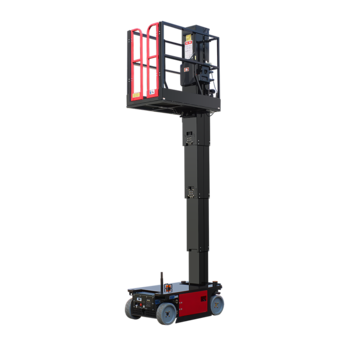Forklift vertical lift is a common heavy-duty material vertical transportation equipment with the advantages of compact structure, strong load-bearing capacity and stable operation. It is widely used in warehousing logistics, industrial manufacturing, workshop circulation and floor cargo handling. In order to ensure the long-term stable operation, safety performance and service life of the equipment, a reasonable operating environment is extremely critical.
Installation space and operation channel requirements
Forklift vertical lifts are usually equipped with fork arm structures and vertical guide rail systems, which require more stringent installation space and traffic areas.
The vertical installation height should meet the maximum travel of the equipment plus the top safety margin. Generally, an additional top space of not less than 300mm should be reserved.
The flat installation position needs to ensure that the platform horizontal transfer and forklift docking are unobstructed. There should be an operation buffer of not less than 1.5 meters in front to facilitate the entry and exit of goods.
The channel width should take into account the platform size, cargo size and operation lane. The recommended width is not less than 1.8 meters to ensure that forklifts or stackers can enter and exit the operation area smoothly.
Obvious area signs and safety fences should be set around the lift to prevent other equipment or personnel from entering by mistake and affecting operational safety.
Requirements for foundation structure and load-bearing capacity
Forklift-type vertical lifts are mostly heavy equipment, and the weight of the structure plus the operating load puts high demands on the ground bearing capacity.
The installation foundation should be made of reinforced concrete structure, with a recommended thickness of not less than 200mm and a load-bearing capacity of not less than 3 tons/square meter.
The foundation needs to be tested for levelness, and the maximum horizontal deviation should not exceed ±3mm to ensure the installation accuracy and lifting stability of the guide rail.
If installed in a floor structure, a qualified structural design unit should be commissioned to perform load calculations to avoid settlement or deformation caused by excessive structural load-bearing.
For open-hole installation, a steel reinforcement frame should be set around the hole and reliably connected to the structural layer through chemical anchors or embedded parts.

Power supply and control system environment requirements
The operation of the equipment depends on the electric drive and control system, and the power supply stability and electrical environment have a significant impact on the performance of the equipment.
The power supply voltage should be configured according to the equipment specifications, generally 380V three-phase AC, the fluctuation range should not exceed ±10%, and the frequency should be stable at 50Hz.
The power supply line should use an independent circuit, be equipped with an air switch and leakage protector, and reserve sufficient grounding wire positions to ensure electrical safety.
The control cabinet should be installed in an independent space that is dust-proof, moisture-proof, and corrosion-resistant to prevent dust, water vapor or oil from invading the control circuit.
Electrical wiring should use wear-resistant and flame-retardant cables and be laid in metal wire troughs or bridges to avoid safety hazards caused by exposed lines.
Ambient temperature and humidity requirements
The electrical, hydraulic and mechanical components of the forklift vertical lift have a certain range of adaptability to the temperature and humidity of the operating environment. Exceeding the threshold will affect normal operation.
The suitable working temperature is -10℃ to +40℃. Special environments such as cold storage and hot processing workshops require the use of low-temperature or high-temperature resistant components and corresponding protection measures.
The relative humidity should be controlled between 40% and 85% to avoid electrical short circuits, rust or deterioration of hydraulic oil caused by condensation or high humidity.
For hot and humid environments, a forced ventilation system or dehumidification equipment should be set up to keep the equipment operating area dry.
If the equipment is operated in an open-air environment, a rain cover and sun-proof insulation board should be installed to ensure that the equipment is not affected by the sun and rain.
Protection level and dust and explosion-proof requirements
The environmental cleanliness and safety risk level of the equipment operation site directly determine its protection level configuration requirements.
It is recommended to configure IP54-level electrical control cabinets and distribution boxes in general industrial environments, which have good dust and splash-proof capabilities.
If used in places with a lot of dust (such as flour mills, cement plants) or gas volatilization, explosion-proof control components should be selected and comply with national explosion-proof equipment certification standards.
Hydraulic system components should be made of high-sealing and corrosion-resistant materials, and oil pipe protection sleeves and return oil filters should be installed to prevent foreign matter from entering the hydraulic circuit.
Safety passages and personnel isolation requirements
Effective isolation between personnel and platforms must be ensured during equipment operation to prevent accidental injury caused by mistaken entry into the lifting area.
The lifting area should be equipped with a protective fence not less than 1.2 meters high, and the passage should be equipped with a safety door with an interlocking device, which can only be opened when the platform is stationary.
The installation location should be equipped with clear warning signs and operating instructions, and infrared or laser safety sensors should be installed to automatically stop lifting when a person approaches.
For multi-floor through-type elevators, independent safety doors and interlocking control systems should be set up on each floor to prevent pinching accidents.










 Español
Español















